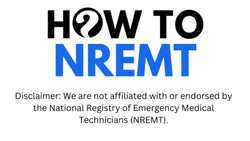Keeping your certification active as an Advanced Emergency Medical Technician (AEMT) is a professional responsibility you can’t afford to overlook. Renewal ensures that your training is current, your skills remain sharp, and you stay eligible for fieldwork. This guide breaks down the recertification requirements for AEMT professionals, covering continuing education (CE), exam options, timelines, and documentation. With clear steps and simple instructions, you can stay compliant and ready to work.
Understanding the Recertification Timeline
The National Registry of Emergency Medical Technicians (NREMT) follows a two-year renewal cycle for AEMTs. The renewal period opens every October 1 and closes on March 31 of the following year. If you fail to recertify by this deadline, your certification may become inactive or expired, depending on your status and how long it's been since your last renewal.
It’s important to plan ahead. Waiting until March creates unnecessary stress. Start the process early to avoid missing deadlines and risking your standing with the National Registry or your state EMS office.
Two Pathways to Renewal
There are two main ways to meet the recertification requirements for AEMT:
1. Continuing Education (CE) Route
2. Cognitive Exam Route
Most AEMTs choose the CE route, but the cognitive exam option is available if you prefer to demonstrate your knowledge through testing rather than coursework.
Continuing Education Requirements (50 Hours)

If you choose the CE pathway, you must complete 50 hours of continuing education as part of the National Continued Competency Program (NCCP). These hours are divided into three components:
● National Component – 25 hours
This portion focuses on core content and clinical updates. Topics include airway management, trauma, cardiac care, EMS operations, and other relevant material outlined by the National Registry.
● Local or State Component – 12.5 hours
These hours address local or regional clinical priorities, protocol updates, or agency-specific content. Your medical director or state EMS office may define what is required here.
● Individual Component – 12.5 hours
You can use this time to focus on personal learning needs, skill gaps, or clinical interests. Topics can include refresher training or advanced patient care content.
All 50 hours can be completed through online education. As of 2025, the National Registry of Emergency Medical Technicians (NREMT) has permanently removed all limits on distributive education (DE) hours for recertification. This makes it easier to complete your CE from home or during downtime at work.
Accepted Continuing Education Formats
Approved CE activities must contribute directly to patient care. Here are acceptable formats:
● CAPCE-approved online courses
● In-person EMS conferences or workshops
● College coursework in EMS-relevant subjects
● Department-led drills or simulations with documentation
● Webinars with interactive components
Make sure any course you take includes proof of completion, the date, provider information, and approval by CAPCE or your state’s EMS authority.
Avoid using general safety or administrative training unless it clearly supports prehospital care. Fire safety, workplace harassment training, or non-clinical workplace modules typically do not count toward CE credit.
Recertification by Cognitive Exam
If you prefer to test instead of completing CE, you can recertify by passing the current AEMT cognitive exam.
Steps to complete the Cognitive Exam route:
1. Log in to your NREMT account and start the “Recertification by Exam” application.
2. Pay the exam fee (see your portal for current cost).
3. Receive an Authorization to Test (ATT) and schedule your exam at a Pearson VUE center.
4. Pass the exam.
5. Complete the attestation confirming continued practice and CPR certification.
This option still requires you to maintain an active CPR card and confirm affiliation with a licensed EMS agency, if required by your state.
Documentation Checklist

To complete the recertification process, be sure to have the following documentation ready:
● CPR Certification: Must be current through March 31 of your renewal year.
● Continuing Education Certificates: Upload PDFs of all CE certificates directly into your Registry portal.
● Agency Affiliation: Your supervisor must confirm your ongoing field or clinical work.
● Self-Assessment: Complete the section in your Registry profile.
● Payment Confirmation: Submit payment before finalizing your application.
Once everything is uploaded and verified, submit your application before the March 31 deadline. Keep a copy of your confirmation for your records and potential audits.
Tips to Avoid Common Pitfalls
A few small mistakes can delay your recertification. Here’s how to avoid them:
● Start Early: Don’t wait until the last month to begin your renewal.
● Verify Course Approval: Only use CE courses that are CAPCE-approved or accepted by your state EMS office.
● Keep Accurate Records: Maintain a log of all courses with dates and topics.
● Check CPR Expiration: Update your card well in advance if it's close to expiring.
● Remind Supervisors: Agency officials must verify your role—don’t leave this step until the last minute.
These simple actions help keep your application on track.
Special Circumstances

Inactive Status
If you’re not currently working in the field but want to keep your certification, you can apply for inactive status. You’ll still need to complete 50 hours of CE, but you won’t need agency verification.
Lapsed Certification
If your certification expired less than two years ago, you must complete a refresher course and take the cognitive exam. If it’s been more than two years, you must follow the full re-entry pathway, which includes 50 CE hours and retesting.
Frequently Asked Questions
Can I do all 50 CE hours online?
Yes. You may complete all required CE hours through distributive education, including self-paced online courses.
What happens if I submit my application late?
If you miss the March 31 deadline, your certification will expire. You’ll need to follow the re-entry process, which includes retesting and additional education.
Does state CE differ from national CE?
It might. Always check with your state EMS office to make sure your CE choices fulfill both national and state requirements.
How To NREMT Can Help You Succeed
Meeting the recertification requirements for AEMT doesn’t end with submitting documents—it also means staying prepared for the cognitive exam if you choose that route. If you’re planning to test, How To NREMT offers the support you need with focused tools designed for success. Our resources include NREMT exam prep online and guidance from experienced NREMT tutors available online to help you build confidence and improve performance.
Whether you're reviewing key topics or looking for structured help, our platform gives you the direction to stay on track. Stay prepared and stay certified. Contact How To NREMT today to start your recertification journey with NREMT test preparation tools and resources.

